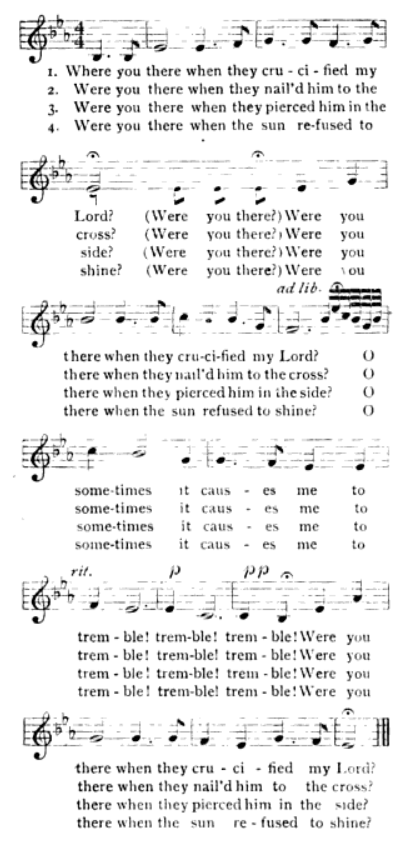Were You There (When They Crucified My Lord) on:
[Wikipedia]
[Google]
[Amazon]
 "Were You There (When They Crucified My Lord)" is an African-American spiritual that was first printed in 1899. It was likely composed by enslaved
"Were You There (When They Crucified My Lord)" is an African-American spiritual that was first printed in 1899. It was likely composed by enslaved
Recording of performance by Paul RobesonRecording of performance by ReThink Worship
{{Authority control African-American spiritual songs American Christian hymns Music based on the Crucifixion of Jesus Lent 1899 songs Songwriter unknown 19th-century hymns United States National Recording Registry recordings
 "Were You There (When They Crucified My Lord)" is an African-American spiritual that was first printed in 1899. It was likely composed by enslaved
"Were You There (When They Crucified My Lord)" is an African-American spiritual that was first printed in 1899. It was likely composed by enslaved African Americans
African Americans (also referred to as Black Americans and Afro-Americans) are an ethnic group consisting of Americans with partial or total ancestry from sub-Saharan Africa. The term "African American" generally denotes descendants of ens ...
in the 19th century.
The song was first published in William Eleazar Barton's 1899 ''Old Plantation Hymns'' but was described in writings prior to this publication. In 1940, it was included in the Episcopal Church hymnal, making it the first spiritual to be included in any major American hymnal. It is also unique in that it is the only African-American song included in the Catholic Church's Liturgy of the Hours.
As reported in Howard Thurman's autobiography, the song was one of Mahatma Gandhi's favorites. The song has been recorded by artists including Paul Robeson, Marion Williams
Marion Williams (August 29, 1927 – July 2, 1994) was an American gospel singer.
Early years
Marion Williams was born in Miami, Florida, to a religiously devout mother and musically inclined father. She left school when she was nine ...
, Johnny Cash
John R. Cash (born J. R. Cash; February 26, 1932 – September 12, 2003) was an American country singer-songwriter. Much of Cash's music contained themes of sorrow, moral tribulation, and redemption, especially in the later stages of his ca ...
, Roy Acuff
Roy Claxton Acuff (September 15, 1903 – November 23, 1992) was an American country music singer, fiddler, and promoter. Known as the "King of Country Music", Acuff is often credited with moving the genre from its early string band and "hoedown ...
, Phil Keaggy
Philip Tyler Keaggy (born March 23, 1951) is an American acoustic and electric guitarist and vocalist who has released more than 55 albums and contributed to many more recordings in both the contemporary Christian music and mainstream markets. H ...
, Max Roach, Diamanda Galás, Harry Belafonte, The Seldom Scene, Diamond Version (with Neil Tennant), Bayard Rustin, Rajaton, and Chris Rice
Chris Rice is an American singer and songwriter who works in the contemporary Christian music, contemporary folk, adult contemporary and adult album alternative genres. He became a recording artist in 1996 after signing a contract with Rocketo ...
. A writer from the '' Indianapolis News'' wrote about Paul Robeson's rendition, saying that "It was as startling and vivid a disclosure of reverent feeling of penetrating pathos as one could imagine."
Lyrics
The following lyrics are those printed in the 1899 Unicorn. ''Old Plantation Hymns''; other variations exist.Lyrical analysis
“Were You There” utilizes a system of coded language in its lyrics like most, if not all, African-American spirituals. Metaphors, especially those involving Old Testament figures, as well as Jesus, are often central to the meanings of spirituals. “Were You There” tells the story of the Crucifixion of Jesus. Underneath this narrative, however, is a metaphor likening Jesus's suffering to the suffering of slaves. In some versions of the song, the singer asks “Were you there when they nailed Him to the Tree?” Replacing Jesus’ cross with a tree further strengthens the metaphor between Jesus’ suffering and slaves’ suffering. African-Americans during the antebellum period, and all the way into the Jim Crow era, would have drawn a connection between Jesus nailed to a tree and the frightening prevalence of lynchings in their own lives. This expression of likening one's experience to Jesus' is underscored by the first-person, present-tense perspective of “Were You There”; the singer personally witnesses the crucifixion. The use of first person pronouns in the spiritual reflects a sense of “communal selfhood” formed by African-American slaves in the face of oppression It should also be noted that this particular hymn and the use of the first person perspective reflects the Christian principle that all of humanity, past, present and future bears the responsibility for their complicity in sin that resulted in the Crucifixion of Jesus Christ. From a lyrical analysis standpoint, the author may have been asking the question in a literal sense, implying that the event should be remembered as if the listener were physically present.References
External links
Recording of performance by Paul Robeson
{{Authority control African-American spiritual songs American Christian hymns Music based on the Crucifixion of Jesus Lent 1899 songs Songwriter unknown 19th-century hymns United States National Recording Registry recordings